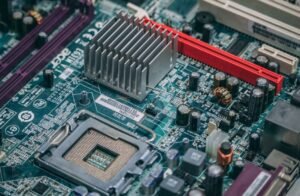Tools Required for Artificial Intelligence
Artificial Intelligence (AI) is an advanced technology that aims to develop intelligent machines capable of performing tasks that typically require human intelligence. To build and deploy AI systems, developers need a range of tools and resources. In this article, we will explore the key tools required for artificial intelligence development and highlight their significance in the AI landscape.
Key Takeaways:
- Artificial Intelligence (AI) requires a variety of tools for development and deployment.
- The key tools for AI development include programming languages, libraries, frameworks, and cloud platforms.
- These tools enable developers to build and deploy AI models efficiently and effectively.
- Artificial intelligence technologies are transforming various industries, such as healthcare, finance, and transportation.
1. **Programming Languages:** Python, R, and Julia are popular programming languages for artificial intelligence. **Python** is widely used for its simplicity and a vast ecosystem of AI libraries.
*Python, with its extensive library support and easy syntax, has become the go-to choice for AI development.*
2. **Libraries**: Libraries such as **TensorFlow, PyTorch, and scikit-learn** provide tools and functions for various AI tasks like deep learning, natural language processing, and data manipulation.
*TensorFlow, one of the most widely used libraries, provides a high-level interface for designing and training neural networks.*
3. **Frameworks**: AI frameworks, like **Keras and MXNet**, offer a higher-level interface over libraries for easy model development and deployment.
*Keras, a popular framework, simplifies the process of building and training AI models by providing a user-friendly interface.*
Tools for AI Development and Deployment:
Artificial intelligence development requires a range of tools to build and deploy AI models. The following table illustrates some essential tools:
| Tool | Description |
|---|---|
| Python | A widely used programming language for AI development due to its simplicity and extensive library support. |
| TensorFlow | An open-source library for machine learning and neural network-based AI models. |
| Keras | A high-level AI framework that simplifies the process of building and training models. |
*These tools collectively empower developers to create robust and efficient AI systems.*
4. **Cloud Platforms**: Cloud platforms such as **Amazon Web Services (AWS), Google Cloud, and Microsoft Azure** offer scalable computing resources and AI services like machine learning APIs, data storage, and model deployment options.
*Cloud platforms provide the necessary infrastructure and services for AI development and deployment, reducing the need for extensive local resources.*
Impact of AI Tools on Industries:
- **Healthcare**: AI tools enable medical professionals to analyze large amounts of patient data to identify patterns, make accurate diagnoses, and predict diseases.
- **Finance**: AI tools help financial institutions automate processes, detect fraud, and improve customer experience through personalized recommendations.
- **Transportation**: AI tools facilitate the development of autonomous vehicles and optimize route planning, improving efficiency and safety.
5. **Data Labeling Tools**: AI models require labeled data for training. Tools like **Labelbox, Amazon SageMaker Ground Truth, and LabelStudio** provide efficient data labeling platforms.
*Data labeling tools ensure accuracy and reliability in training AI models by providing clear annotations and labels.*
Additional Tools for AI Model Evaluation:
- **AutoML**: Automated Machine Learning tools like **Google Cloud AutoML and H2O.ai** simplify the machine learning pipeline, automating tasks like feature selection, hyperparameter tuning, and model evaluation.
- **Jupyter Notebooks**: Jupyter notebooks provide an interactive environment for iterative development and experimentation with AI models.
- **Visualization Tools**: Tools like **Matplotlib and Tableau** allow visualizing AI model outputs and analyzing trends in data.
Artificial intelligence has revolutionized various industries, and the availability of diverse tools and resources has accelerated its growth. By utilizing the right tools, developers can create AI systems that have a profound impact on society.

Common Misconceptions
1. Artificial Intelligence Requires Expensive Hardware
One common misconception about artificial intelligence is that it necessitates expensive hardware to operate effectively. While it is true that some AI applications, such as deep learning tasks, can benefit from high-performance hardware like GPUs, there are numerous AI tools and frameworks available that can run on less powerful machines.
- AI applications can be run on standard consumer-grade computers with sufficient memory and processing power.
- Cloud services, such as Amazon Web Services (AWS) or Google Cloud Platform (GCP), offer affordable AI solutions that eliminate the need for expensive hardware.
- With advancements in technology, AI is becoming increasingly accessible and can be implemented on low-cost devices like smartphones and embedded systems.
2. Programming Skills Are Mandatory for AI Development
Another common misconception is that you must possess advanced programming skills to develop AI systems. While programming skills are undoubtedly valuable in AI development, they are not always mandatory. There are various AI tools and platforms available today that enable individuals with limited coding knowledge to build and deploy AI models.
- AI visual programming tools like TensorFlow’s Keras or Google’s AutoML allow non-programmers to create machine learning models using a graphical interface.
- AI development platforms, such as IBM Watson or Microsoft Azure AI, provide pre-built modules and services that simplify AI implementation for non-technical users.
- With the rise of no-code and low-code platforms, individuals without extensive programming experience can still contribute to AI projects by utilizing drag-and-drop interfaces and pre-built AI components.
3. AI Can Fully Replace Human Intelligence
Many people hold the misconception that AI has the potential to entirely replace human intelligence. While artificial intelligence can perform complex tasks and process vast amounts of data, it still lacks the depth of human understanding and creativity at present.
- AI systems may excel in specific areas, such as image recognition or data analysis, but struggle to replicate human emotional intelligence or critical thinking.
- The combination of human skills, such as intuition, empathy, and common sense, with AI technology can result in more powerful and comprehensive outcomes.
- AI is designed to assist and augment human capabilities rather than replace them completely, leading to improved efficiency and productivity in various fields.
4. AI Is Only Beneficial for Large Enterprises
A widespread misconception is that AI is solely advantageous for large enterprises with substantial resources. However, AI technology can provide significant benefits to businesses of all sizes, including startups and small businesses.
- AI-driven automation can streamline repetitive tasks, reducing operational costs and improving productivity, which is beneficial to companies of any scale.
- AI-powered chatbots and virtual assistants enhance customer support and engagement, providing small businesses with a cost-effective means of delivering top-notch service.
- Smaller organizations can leverage AI analytics tools to gain valuable insights into their operations, enabling data-driven decision-making and competitive advantage.
5. AI Is Harmful and Will Eliminate Jobs
There is a common misconception that the proliferation of AI will lead to massive job losses and increased unemployment. While AI has the potential to automate certain tasks, it also creates new opportunities and job roles that require human expertise.
- AI can free up human workers from repetitive and mundane tasks, allowing them to focus on more complex and creative endeavors within their respective fields.
- AI generates a demand for skilled professionals who can develop and manage AI systems, leading to the emergence of new job opportunities.
- Historically, technological advancements have resulted in job transformations rather than complete job elimination, as people adapt their skills and roles to work alongside AI technologies.

Overview of Artificial Intelligence Tools
Artificial Intelligence (AI) is revolutionizing various industries by enabling machines to perform tasks that typically require human intelligence. To harness AI’s capabilities, a range of tools and technologies are utilized. This article explores ten essential tools required for artificial intelligence, showcasing their features and benefits.
Table 1: Machine Learning Frameworks
Machine learning frameworks provide a foundation for developing AI models. These frameworks offer libraries and tools to build, train, and deploy machine learning algorithms efficiently.
Table 2: Natural Language Processing (NLP) Libraries
Natural Language Processing tools enable machines to understand, interpret, and generate human language. NLP libraries consist of algorithms and functionalities that aid in processing textual data.
Table 3: Computer Vision Libraries
Computer Vision libraries facilitate AI systems to interpret and analyze visual data from images or videos. These libraries provide various algorithms for object recognition, image segmentation, and motion tracking.
Table 4: Neural Network Architectures
Neural networks are fundamental components of AI systems. Different architectures, such as convolutional neural networks (CNNs) and recurrent neural networks (RNNs), serve distinct purposes for tasks like image recognition and sequence learning.
Table 5: Cloud AI Platforms
Cloud AI platforms offer a scalable and accessible environment to build and deploy AI applications. These platforms provide pre-trained models, automated machine learning, and extensive computing resources.
Table 6: Data Annotation Tools
Data annotation tools aid in labeling large datasets, a crucial step in training AI models. These tools streamline the process by providing annotation interfaces, collaborative features, and data management capabilities.
Table 7: Reinforcement Learning Libraries
Reinforcement learning libraries empower AI agents to learn by interacting with environments and receiving feedback. These libraries often consist of algorithms, environments, and training utilities.
Table 8: Speech Recognition APIs
Speech recognition APIs enable automatic conversion of spoken language into written text. These APIs employ advanced language models and deep learning techniques to accurately transcribe audio inputs.
Table 9: AI Development Platforms
AI development platforms encompass integrated toolsets for creating end-to-end AI solutions. They typically offer features like model training, deployment, monitoring, and data management within a unified interface.
Table 10: Explainable AI Tools
Explainable AI tools aim to bring transparency to AI decision-making processes. These tools provide insights and explanations for the reasoning behind AI model predictions and recommendations.
In conclusion, navigating the expansive field of artificial intelligence requires leveraging a diverse range of tools. From machine learning frameworks to explainable AI tools, each component plays a vital role in shaping AI solutions. By combining these tools effectively, organizations can unlock the full potential of AI and drive innovation across various domains.
Tools Required for Artificial Intelligence
Frequently Asked Questions
What are the essential tools for artificial intelligence?
Some essential tools for artificial intelligence include programming languages like Python and R, machine learning libraries/frameworks like TensorFlow and PyTorch, data visualization tools like Matplotlib and Tableau, and cloud platforms like AWS and Google Cloud Platform.
Why is Python commonly used in AI development?
Python is commonly used in AI development due to its simplicity, readability, and a rich set of libraries and frameworks specifically designed for AI tasks. It provides efficient data processing and manipulation capabilities, making it an ideal language for AI projects.
What is the role of TensorFlow in AI?
TensorFlow is an open-source machine learning framework used for building and training neural networks. It provides a flexible architecture to develop complex AI models, supports distributed computing, and offers various tools and libraries for efficient development and deployment of AI applications.
Why is data visualization important in AI?
Data visualization is important in AI as it helps in understanding and interpreting complex patterns and relationships within the data. Visualizations provide insights and aid decision-making, enabling AI practitioners to identify trends, anomalies, and optimize AI models.
What is the role of cloud platforms in AI?
Cloud platforms like AWS and Google Cloud Platform offer scalable computing resources and pre-configured AI services. They provide the infrastructure required for training and deploying AI models, along with built-in tools for data storage, processing, and analysis. Using cloud platforms allows for efficient development and deployment of AI applications without the need for extensive on-premises resources.
How is R used in AI development?
R is a programming language commonly used in AI development for statistical analysis and data visualization. It offers a wide range of libraries and packages for machine learning, making it suitable for tasks such as data preprocessing, model building, and evaluation.
What are some popular machine learning libraries?
Some popular machine learning libraries/frameworks include TensorFlow, PyTorch, scikit-learn, Keras, and Caffe. These libraries provide pre-built functions and algorithms for various machine learning tasks, making it easier for developers to build AI models.
Which tools help in the deployment of AI models?
Tools like Docker and Kubernetes aid in the deployment of AI models. Docker provides a containerization platform that allows for consistent and reproducible deployment across different environments, while Kubernetes manages these containers at scale, ensuring efficient utilization of computing resources.
What is the role of natural language processing (NLP) in AI?
Natural language processing (NLP) is a branch of AI that focuses on the interaction between humans and machines using natural language. It enables the understanding, interpretation, and generation of human language by machines, facilitating tasks such as sentiment analysis, language translation, and chatbot development.
Are there any specific hardware requirements for AI development?
While AI development can be done on standard computer hardware, certain tasks like training deep learning models may require high-performance GPUs (Graphics Processing Units) due to their computational demands. However, cloud platforms provide GPU instances that can be used for AI development without the need for expensive hardware.





